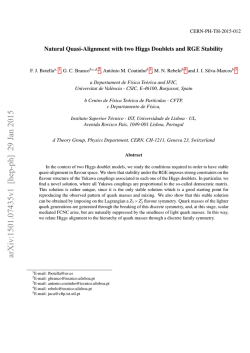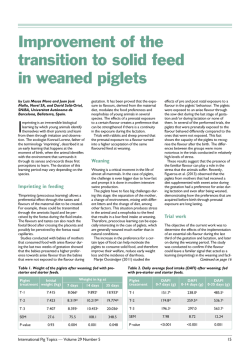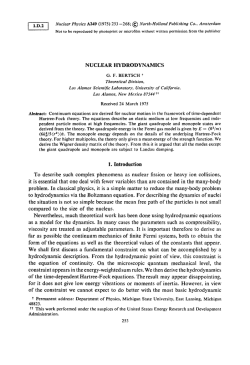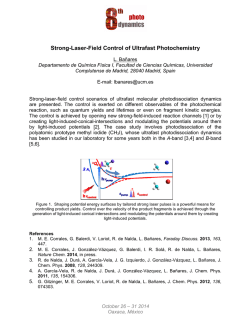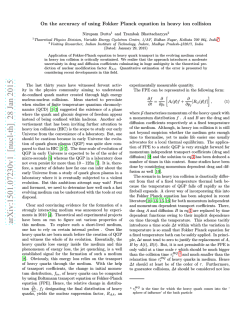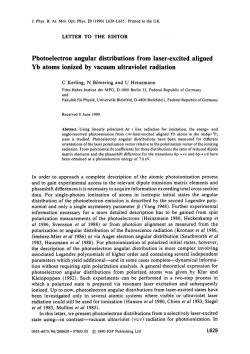
1 - arXiv
ULB-TH/15-01, CERN-PH-TH-2015-010 The Flavour Portal to Dark Matter Lorenzo Calibbi,1 Andreas Crivellin,2 and Bryan Zald´ıvar1 arXiv:1501.07268v1 [hep-ph] 28 Jan 2015 1 Service de Physique Th´eorique, Universit´e Libre de Bruxelles, C.P. 225, B-1050 Brussels, Belgium 2 CERN Theory Division, CH-1211 Geneva 23, Switzerland We present a class of models in which dark matter (DM) is a fermionic singlet under the Standard Model (SM) gauge group but is charged under a symmetry of flavour that acts as well on the SM fermions. Interactions between DM and SM particles are mediated by the scalar fields that spontaneously break the flavour symmetry, the so-called flavons. In the case of gauged flavour symmetries, the interactions are also mediated by the flavour gauge bosons. We first discuss the construction and the generic features of this class of models. Then a concrete example with an abelian flavour symmetry is considered. We compute the complementary constraints from the relic abundance, direct detection experiments and flavour observables, showing that wide portions of the parameter space are still viable. Other possibilities like non-abelian flavour symmetries can be analysed within the same framework. I. INTRODUCTION Establishing the nature of dark matter (DM) is one of the fundamental open problems in particle physics and cosmology. A weakly interacting massive particle (WIMP) is an excellent candidate since (for GeV to TeV scale masses) it naturally provides a relic abundance consistent with observations [1]. Since WIMPs must be weakly interacting, a likely possibility is that DM is a singlet under the Standard Model (SM) gauge group. In this case the interactions with the SM particles are transmitted by mediators, i.e. by the “dark sector”. Many possibilities for mediators haven been discussed in the literature, among them Z models [2–5], Higgs portal models [6–10], dark color [11–13] and models with flavoured DM [14–19]. Flavour models aim at explaining the Yukawa structure by introducing a flavour symmetry under which the SM fermions transform non-trivially. After this symmetry is spontaneously broken by scalar fields (i.e. flavons), the observed fermions masses and mixing angles are generated as non-renormalisable operators. Froggatt and Nielsen proposed the first flavour model by introducing an abelian U (1) flavour symmetry and heavy vector-like quarks [20]. Later on, many other possibilities have been studied, among them SU (2) [21, 22], SU (3) [23] as well as discrete flavour symmetries like A4 [24]. In this article we propose a new mechanism generating the interactions of DM with the visible sector: DM and the SM particles are charged under a flavour symmetry and interact with each other only via flavour interactions. 1 This is an appealing possibility since it is minimal in the sense that no ad hoc quantum numbers must be introduced and DM interactions are described by the same 1 Note that our framework shares this starting assumption with some flavoured DM models, e.g. [15, 16, 18, 19]. Nevertheless, the crucial difference is that we propose either flavour-breaking scalars or flavour gauge bosons as the only mediators between the dark and the SM sectors. dynamics generating fermion masses in the SM. Furthermore, relating Dark Matter and flavour models provides a handle on the otherwise unspecified flavour-breaking scale, motivating the possibility of low-energy realisations with interesting phenomenology that would allow insights into the flavour sector [25]. II. GENERAL SETUP In this section, we examine the generic features of “flavour portal” models that do not depend on the specific implementation, e.g. the transformation properties of SM and DM fields under the flavour symmetry. In models `a la Froggatt-Nielsen [20, 26–29], a new symmetry of flavour (GF ), under which the SM fermions are charged, is introduced, such that the Yukawa couplings of the SM are forbidden at the renormalisable level (with the possible exception of the top Yukawa) and fermion masses arise once the symmetry is broken as higher dimensional operators: (mf )ij = afij φ M nfij v √ . 2 (1) Here v ∼ = 254 GeV is the vev of the SM Higgs h and φ represents one or more scalar fields, the flavons, whose vev breaks the flavour symmetry. M is a cutoff that can be interpreted as the mass of vector-like fermions, that constitute the UV completion of the model.2 The exponents nfij are dictated by the transformation properties of the fields under GF , while afij are unknown coefficients originating from the fundamental couplings of SM fields, flavons and messengers in the UV-complete theory. They 2 In Ref. [30] it has been discussed that heavy scalars with the quantum numbers of the SM Higgs field can also be used for a similar mechanism. Model building details and phenomenology of the messenger sector have been discussed in Ref. [25, 30]. 2 are commonly assumed to be O(1), so that the the observed hierarchies of the Yukawas are solely accounted for by the flavour symmetry breaking. This can be done by a suitable choice of the flavour charges or representations of the SM fermions (one can assume that the Higgs field is neutral under GF ), provided that ≡ φ /M is a small expansion parameter, typically of the order of the Cabibbo angle or smaller. χ f χ f χ χ ∼ mχ ⟨φ⟩ ∼ mf ⟨φ⟩ (a) mχ = bχ φ M φ , (2) where again bχ is an O(1) coefficient and nχ depends on the flavour representations/charges of χL and χR . Note that in this setup the stability of the DM particles is automatically guarantied (at least for what concerns the quark sector) by an accidental symmetry related to their singlet nature. From Eqs. (1, 2) we can obtain the couplings of both DM and SM fermions to a dynamical flavon, without further specifying the details of the model: mf mχ fL fR φ + (nχ + 1) χL χR φ φ φ ≡ λf fL fR φ + λχ χL χR φ . L ⊃ nf (3) Here, we suppressed flavour indices but one has to keep in mind that the couplings to fermions are in general flavour changing. In fact, λf is not diagonal in the same basis as the fermion mass matrix mf , as a consequence of the flavour dependence of the exponents nf . The above expressions can be easily generalised to the case of multiple flavons. For what concerns the flavon mass, we assume that it also arises from the flavour symmetry breaking, such that: mφ = k φ . (4) Since we are not going to specify the details of the scalar potential and the symmetry breaking, we take k as a free parameter. From the above Lagrangian, we can see that our setup shares some similarities to the Higgs-portal scenario [6– 10], in particular the fact that the mediator prefers to mχ ⟨φ⟩ φ f Z nχ ∼ φ (b) GF as a global symmetry If the flavour symmetry is global, there are no extra gauge bosons associated to it, so that for a DM particle which carries flavour charge, the only interactions with the visible sector are through flavon fields φ. In particular, we are going to consider two chiral fermions χL and χR , which are SM singlets but transform non-trivially under GF . In perfect analogy with the SM fermions, the DM particle acquires a Dirac mass term though the flavour symmetry breaking: mχ ⟨φ⟩ φ χ A. ∼ χ ∼ gF ′ ∼ gF f (c) FIG. 1: Feynman diagrams contributing to DM annihilation in presence of light flavons (a) and (b) and light flavour gauge bosons (c). couple to heavier fermions, but also the possible correlations between the DM annihilation and scattering with nuclei. In Fig. 1 we show the Feynman diagrams (a) and (b) contributing to DM annihilation in presence of light flavons. Notice that the contribution (b) requires mχ > mφ . From the figure, we can immediately infer the parametric dependence of the annihilation processes we are interested in. Concerning the s-channel processes (a), we see that the thermally-averaged annihilation cross section mediated by flavons scales as: σφS v ∼ λ2χ λ2f mχ T, (4m2χ − m2φ )2 + Γ2φ m2φ (5) where the flavon decay width Γφ depends on λ2f and λ2χ . From Eq. (3), we see that the flavon-mediated process preferably involves the heaviest fermions that are kinematically accessible and it can be doubly suppressed in the case of heavy flavons: both by the propagator and by the couplings (that scale as 1/mφ ). This is the reason why, as we will see in the explicit example of the next sections, the correct relic abundance might require a resonant enhancement of the annihilation cross section, i.e. mχ mφ /2. Note also that the annihilation cross section in Eq. (5) depends linearly of the temperature, which is a consequence of the velocity-suppression of the process. The contribution of the diagram (b) of Fig. 1 scales like σφt v ∼ λ4χ T m3χ (6) in the limit mχ mφ , and features a p-wave suppression as well. Elastic DM-nuclei scattering can only be mediated by φ, hence being controlled by the same couplings depicted in the diagram (a) of Fig. 1. Therefore, the parametric 3 dependence of the spin-independent cross section is: σφSI ∼ λ2χ λ2φN 2 µχN , m4φ (7) Here µχN is the DM-nucleon reduced mass, and λφN ∝ λf is the scalar couplings to nucleons [31]. B. GF as a local symmetry u yij = auij We also consider the possibility that the flavour symmetry is gauged, leading to extra gauge boson(s) with coupling gF . The phenomenology of the model drastically changes. The reason is that the couplings of fermions and dark matter to Z are completely determined by the flavour charges (QX in our abelian example) of the particles: L ⊃ gF χγ µ (QχL PL + QχR PR )χ Zµ + gF f γ µ (QfL PL + QfR PR )f Zµ . (8) As we can see, the couplings are not suppressed by the flavour-breaking scale, as in the case of flavon mediation. Furthermore, unlike flavons, flavour gauge bosons do not preferably couple to heavy flavours and the DM annihilation, depicted in Fig. 1 (c), is potentially efficient even for flavour-breaking scales well above the TeV. In fact, the flavour gauge bosons can be substantially lighter than flavons if the coupling is weak.√ In fact, in the abelian example above we have mZ = 2gF φ . Of course, too small values of gF would suppress the annihilation even if Z is light. From the diagram (c) of Fig. 1, we see that: σZ v ∼ (m2Z − gF4 2 4mχ )2 + Γ2Z m2Z m2χ , (9) where the Z width ΓZ is proportional to gF2 . Also, as we can see the s-channel annihilation is not p-wave suppressed (unlike the flavon-mediation case). As in the flavon case the Z interactions are in general flavour-violating, since quarks of different families couple in general differently to the Z . This feature is going to induce severe constraints on the Z mass from flavour observables. The direct detection interaction is also determined by the gauge boson exchange: SI σZ ∼ gF2 λ2Z m4Z N µ2χN . The vector coupling to the nucleons is λZ III. flavour interactions. For simplicity we choose a FroggattNielsen U (1)F model.3 We assign flavour charges to the SM quarks, Qqi , Qui and Qdi . The SM scalar doublet is neutral under U (1)F and the flavour symmetry is broken by a single flavon with Qφ = −1. In addition we introduce new fermion which are singlets under the SM gauge group but carry U (1)F charges: the dark matter particles. The SM Yukawas read: ∝ gF . Qqi +Qdj , (11) (u,d) (VLu )† y u VRu ≡ yˆu , (VLd )† y d VRd ≡ yˆd , (12) where yˆ(u,d) are diagonal matrices. Given the hierarchical structure of the Yukawas, the rotations are approximated by ratios of the Yukawa entries: (u,d) (u,d) (u,d) (VL )ij ≈ yij (u,d) yjj = (u,d) (u,d) (VR )ij ≈ yji (u,d) yjj aij Qqi −Qqj (u,d) ajj , (13) (u,d) = aji Q(ui ,di ) −Q(uj ,dj ) (u,d) ajj , (14) where i ≥ j. From Eq. (11), it follows that the couplings to a dynamical flavon defined in Eq. (3) are given by (u,d) λij (u,d) = aij (Qqi + Q(uj ,dj ) ) Qqi +Q(uj ,dj ) v , φ (15) Using the above expressions for the rotations, we can then easily estimate the couplings λ(u,d) in terms of fermion masses and mixing angles. For instance, we have: λu12 ≈ (Qq1 + Qu2 )mc (VLu )12 / φ , λu21 ≈ (Qq2 + Qu1 )mc (VRu )12 / φ . (16) (17) As we can see, these couplings are thus expressed in terms of physical observables with the residual uncertainty from the unknown O(1) coefficients encoded in the VL and VR rotations.4 The DM mass arises as in Eq. (2) with the exponent given by: nχ = QχL + QχR − 1. 3 CONSTRUCTION OF AN EXPLICIT MODEL 4 Let us now consider an explicit example of our general idea that DM is communicating with the SM fields via d yij = adij , where aij are assumed to be O(1) numbers and ≡ φ /M . We take = 0.2 to reproduce the observed quarks hierarchies and define the rotations to the fermion mass basis as (10) N Qqi +Quj (18) In the case the symmetry is global, we should rather consider a discrete subgroup ZN ⊂ U (1), in order to avoid massless NambuGoldstone bosons. For large enough N , this does not substantially modify the effective theory, such that we can still work in terms of charges of a continuous U (1) [27]. Given the hierarchical structure of the Yukawa, the order of magnitude of the entries of λ(u,d) do not change after rotating to the mass basis, only the unknown O(1)s are modified. 4 Therefore, the model with the global U (1)F is completely defined – up to O(1) coefficients – by the parameters: mφ , mχ , k ≡ mφ / φ , (19) where a given value of mχ can be obtained by suitable choices of QχL , QχR and bχ . There are few possibilities how U (1)F can be chosen such that the measured fermion masses and mixing can be reproduced. Out of the possibilities outlined in [32], here we adopt the following example: (Qq1 , Qq2 , Qq3 ) = (3, 2, 0), (Qu1 , Qu2 , Qu3 ) = (3, 2, 0), (Qd1 , Qd2 , Qd3 ) = (4, 2, 2). (20) Note that, since for us Qq3 = Qu3 = 0, we have λu33 = 0, i.e. no unsuppressed coupling of the flavon to the top. As a consequence the largest coupling of the flavon is flavour violating: φ tL,R cR,L . In the case U (1)F is local, we additionally have a Z whose couplings are shown in Eq. (8). Given the charge assignment above, couplings to light generations are larger. Furthermore, once the rotations in Eq. (12) are applied to go to the fermion mass basis, flavourviolating couplings arise from Eq. (8), of the form ∼ (u,d) (Qqj −Qqi )×(VL )ij . This induces Z -mediated FCNC at tree-level, setting strong limits on the gauge coupling gF for a given Z mass. The above adopted charge assignment is anomalous [32], as it is a common feature of U (1)F models that successfully reproduce the fermion masses and mixing [28, 29, 33, 34]5 . As the usually invoked Green-Schwarz mechanism would require a flavour-breaking scale close to the Planck scale, we have to assume that anomalies are canceled by the unspecified field content of the hidden and/or the messenger sector. In particular, if the flavour messengers are heavy quarks in vector-like representations of the SM gauge group, they do not need necessary to be vector-like under the flavour symmetry too, leaving large freedom to cope with the U (1)F anomalies. IV. PHENOMENOLOGICAL ANALYSIS A. Flavour Constraints As we have seen, both in the global and in the local version of our U (1)F example FCNC are appear at treelevel. Using the bounds on FCNC operators reported in [25, 35], we can estimate the limits on the flavon/Z mass. Conservatively, we assume that CP violating phases are suppressed, ignoring the bounds from CPV observables 5 However, cf. an anomaly-free solution presented in [33]. like K . The strongest limit to the flavon mass comes from the (sL dR )(sR dL ) operator, while in the Z case from (sL γ µ dL )(sR γµ dR ), both contributing to K − K mixing: √ mφ > ∼ C × k × 830 GeV , gF mZ > (21) ∼ C × 10−3 × 460 GeV. In the flavon case, the parameter C is a product of fundamental O(1) Yukawa-like couplings which can still conspire to relax the bound to some extent. In the Z case, the uncertainty parameterised by C is due to the O(1) coefficients entering the rotations in Eqs. (13, 14). The fields that constitute the UV completion of Froggatt-Nielsen models (vector-like quarks or heavy scalars) can give contributions to the FCNC that are larger than those mediated by flavon exchanges [25], even though they enter at the one-loop level. The reason is that the flavon couplings are proportional to the fermion masses, suppressing processes involving light generations. Adopting the model-independent approach of [25], we find that, in our model, the strongest bound (again in the hypothesis of suppressed phases) to the messenger scale comes from D − D mixing and it can be translated to a limit on the flavon mass: mφ > ∼ C × k × 2.3 TeV. (22) Again, C parameterises a product of unknown O(1) coefficients. B. Relic abundance and Direct Detection We have implemented our model in the MicrOmegas code [36] in order to obtain an accurate numerical calculation of the relic abundance and the direct detection cross section. In the case of a global U (1)F , we work with the free parameters mφ , mχ , k ≡ mφ / φ and set the O(1) coefficients to unity. In the gauged case, we have in addition mZ and gF and the dependence on unknown coefficients (in the fermion rotation matrices) is much milder. We require the relic abundance not to overshoot the Planck measurement [1], taking as a conservative limit ΩDM h2 ≤ 0.13. Global U (1)F case. The results for the global case are shown in the first plot of Fig. 2. As we can see, besides the flavon resonance, there is a wide region with mχ > mφ where efficient annihilation is provided by diagram (b) of Fig. 1 and FCNC constraints are satisfied. Conservatively, we consider here only the effects of flavon exchange and not the more stringent bounds that rely on the additional assumption of a weakly-coupled messenger sector at the scale M . The points shaded in grey at low values of mφ do not fulfil the LUX constraints [37], shown in the second plot. As we can see, most of the parameter space has good prospects to be tested by next generation direct searches experiments and the only points that might 5 FIG. 2: Left: points with ΩDM h2 ≤ 0.13 in the (mχ , mφ ) plane for different values of k. The dashed lines represents the corresponding lower bounds on mφ from FCNC constraints. Centre: nucleon-DM scattering cross section scaled by the actual DM density ξ · σSI (with ξ ≡ Ωχ h2 /0.11) for the same points as before. Right: (gF , MZ ) plane in the local U (1)F case; only the green band is allowed by all data. be hidden under the neutrino background correspond to resonant annihilating DM with mχ > ∼ 1 TeV. Local U (1)F case. In the local case, we find that the only viable possibility to fulfill the relic density bounds relies on resonant Z exchange, mχ ≈ mZ /2, as a consequence of the stringent FCNC constraint of Eq. (21). Hence, we varied gF and mZ and scanned mχ around the resonant condition. The result is shown in the right plot of Fig. 2. We see that for a given mZ , too small values of gF cannot give the correct relic density, even on the resonance, while there is an upper bound on gF from the FCNC bound of Eq. (21) and the limit given by direct detection experiments is comparably much weaker. As a result, only a narrow strip, depicted in green, is still viable. The best way to probe this surviving region seems to rely on an increased sensitivity of FCNC constraints, especially in the D − D and K − K systems. C. Collider signals There are in principle very interesting signals that can be searched for at the LHC. In fact, the largest branching ratio of the flavon is φ → tc, tc, which is around 60%, but also the bb or bs channels are sizeable (while the BR to χχ is very suppressed because it is at threshold or below due to relic density constraints), leading for example to final states like pp → ttcc or pp → bbbb. However, the production cross section of φ is small, at the level of 0.1(10−3 ) fb for LHC@14 TeV for flavons with mφ = 500 (1000) GeV, values already at the edge of the flavour constraints. A similar situation happens in the Z case, where flavour bounds make any LHC signal very challenging. V. CONCLUSIONS AND OUTLOOK In this article we discussed the possibility that the DM particle is a singlet under the SM gauge group but car- ries flavour charges, such that it can communicate with the SM only through flavour gauge bosons or flavourbreaking scalars. We discussed the general features of such flavour portal scenario. We studied an explicit example with an abelian U (1) flavour symmetry. For this model the relevant phenomenological constraints are relic density, direct detection and flavour observables. These measurements often constrain the model to be close to the resonant regime mχ ∼ mφ,Z /2, but still future direct detection experiments will be able to probe an important part of the parameter space of the model. Extensions of these kinds of models to the leptonic sector are straightforward. Without entering the details, here we just notice that, for the sake of dark matter stability, mixing of the χ singlets with neutrinos must be avoided, e.g. by enforcing a conserved symmetry (a natural choice would be the lepton number itself) or by a suitable construction of the UV completion of the model. While we illustrated our concept for a specific model, the basic features of flavour portals models as discussed in Sec. II are generic. On the other hand, the details of the phenomenology will depend of the specific realisation. Therefore it will be interesting to extend the above discussion to different charges assignments or other flavour groups, in particular non-abelian symmetries. Acknowledgments.— The authors are grateful to the Mainz Institute for Theoretical Physics (MITP) for hospitality and partial support during the workshop “Probing the TeV scale and beyond” where this project was initiated. We thank P. Tziveloglou for useful discussions. AC is supported by a Marie Curie Intra-European Fellowship of the European Community’s 7th Framework Programme under contract number (PIEF-GA-2012-326948). The work of BZ is supported by the IISN, an ULB-ARC grant and by the Belgian Federal Science Policy through the Interuniversity Attraction Pole P7/37. 6 [1] P. Ade et al. (Planck Collaboration), Astron.Astrophys. 571, A1 (2014), 1303.5062. [2] P. Langacker, Rev.Mod.Phys. 81, 1199 (2009), 0801.1345. [3] X. Chu, T. Hambye, and M. H. Tytgat, JCAP 1205, 034 (2012), 1112.0493. [4] A. Alves, S. Profumo, and F. S. Queiroz, JHEP 1404, 063 (2014), 1312.5281. [5] G. Arcadi, Y. Mambrini, M. H. G. Tytgat, and B. Zaldivar, JHEP 1403, 134 (2014), 1401.0221. [6] B. Patt and F. Wilczek (2006), hep-ph/0605188. [7] A. Djouadi, Phys.Rept. 457, 1 (2008), hep-ph/0503172. [8] L. Lopez-Honorez, T. Schwetz, and J. Zupan, Phys.Lett. B716, 179 (2012), 1203.2064. [9] A. Djouadi, A. Falkowski, Y. Mambrini, and J. Quevillon, Eur.Phys.J. C73, 2455 (2013), 1205.3169. [10] A. Greljo, J. Julio, J. F. Kamenik, C. Smith, and J. Zupan, JHEP 1311, 190 (2013), 1309.3561. [11] R. Kitano and I. Low, Phys.Rev. D71, 023510 (2005), hep-ph/0411133. [12] R. Kitano, H. Murayama, and M. Ratz, Phys.Lett. B669, 145 (2008), 0807.4313. [13] Y. Bai and P. Schwaller, Phys.Rev. D89, 063522 (2014), 1306.4676. [14] M. Hirsch, S. Morisi, E. Peinado, and J. Valle, Phys.Rev. D82, 116003 (2010), 1007.0871. [15] J. Kile and A. Soni, Phys.Rev. D84, 035016 (2011), 1104.5239. [16] J. F. Kamenik and J. Zupan, Phys.Rev. D84, 111502 (2011), 1107.0623. [17] M. Boucenna, M. Hirsch, S. Morisi, E. Peinado, M. Taoso, et al., JHEP 1105, 037 (2011), 1101.2874. [18] L. Lopez-Honorez and L. Merlo, Phys.Lett. B722, 135 (2013), 1303.1087. [19] P. Agrawal, M. Blanke, and K. Gemmler, JHEP 1410, 72 (2014), 1405.6709. [20] C. Froggatt and H. B. Nielsen, Nucl.Phys. B147, 277 (1979). [21] A. Pomarol and D. Tommasini, Nucl.Phys. B466, 3 (1996), hep-ph/9507462. [22] R. Barbieri, G. Dvali, and L. J. Hall, Phys.Lett. B377, 76 (1996), hep-ph/9512388. [23] S. King and G. G. Ross, Phys.Lett. B520, 243 (2001), hep-ph/0108112. [24] G. Altarelli and F. Feruglio, Nucl.Phys. B720, 64 (2005), hep-ph/0504165. [25] L. Calibbi, Z. Lalak, S. Pokorski, and R. Ziegler, JHEP 1207, 004 (2012), 1204.1275. [26] M. Leurer, Y. Nir, and N. Seiberg, Nucl.Phys. B398, 319 (1993), hep-ph/9212278. [27] M. Leurer, Y. Nir, and N. Seiberg, Nucl.Phys. B420, 468 (1994), hep-ph/9310320. [28] L. E. Ibanez and G. G. Ross, Phys.Lett. B332, 100 (1994), hep-ph/9403338. [29] P. Binetruy and P. Ramond, Phys.Lett. B350, 49 (1995), hep-ph/9412385. [30] L. Calibbi, Z. Lalak, S. Pokorski, and R. Ziegler, JHEP 1206, 018 (2012), 1203.1489. [31] A. Crivellin, M. Hoferichter, and M. Procura (2013), 1312.4951. [32] P. H. Chankowski, K. Kowalska, S. Lavignac, and S. Pokorski, Phys.Rev. D71, 055004 (2005), hepph/0501071. [33] E. Dudas, S. Pokorski, and C. A. Savoy, Phys.Lett. B356, 45 (1995), hep-ph/9504292. [34] P. Binetruy, S. Lavignac, and P. Ramond, Nucl.Phys. B477, 353 (1996), hep-ph/9601243. [35] G. Isidori, Y. Nir, and G. Perez, Ann.Rev.Nucl.Part.Sci. 60, 355 (2010), 1002.0900. [36] G. B´elanger, F. Boudjema, A. Pukhov, and A. Semenov (2013), 1305.0237. [37] D. Akerib et al. (LUX Collaboration) (2013), 1310.8214.
© Copyright 2025
